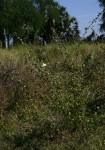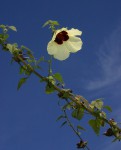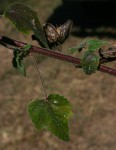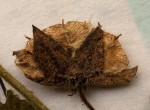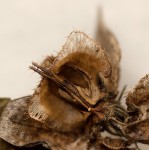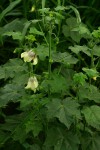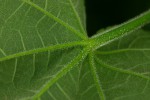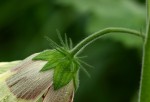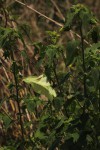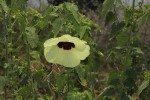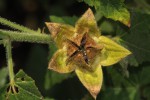Hibiscus vitifolius
vitifolius
Selected images: Click on each image to see a larger version and details of the record View all images (15)
Detailed records: Display species records QDS maps by: Google Maps Point records by Google Maps
Species details: Click on each item to see an explanation of that item (Note: opens a new window)
| Synonyms: |
subsp. vulgaris Brenan & Exell |
| Common names: | |
| Frequency: | Frequent |
| Status: | Native |
| Description: |
Shrubby, sometimes scrambling perennial herb, up to 1.5 m high. Stems usually hairy and glandular, occasionally nearly hairless. Leaves unlobed or shallowly 3-7-lobed, more or less densely stellate hairy to almost hairless, more or less broadly ovate; 5-9-veined from the truncate or cordate base; margin serrate. Flowers 5-9 cm in diameter, yellow with a dark purple-red centre, solitary, axillary or apparently forming terminal racemes due to reduction of the upper leaves. Epicalyx of c. 10 bracts, filiform, 8-10 mm long. Calyx with broadly elliptic lobes up to 15 mm long, hairy, joined to about half-way. Capsule, up to 12 × 15 mm, winged, bristly. |
| Type location: |
Angola |
| Notes: |
Note-1: the form found in forest is nearly hairless and has more deeply lobed leaves. This form is often called subsp. vitifolius while the more widespread form form grassland and woodland habitats, as shown in the photographs, is known as subsp. vulgaris Brenan & Exell. There is some uncertainty regarding the validity of this taxonomic distinction. Note-2: This species is only recognized easily when the distinctly winged capsules (image 5 & 6) are present. |
| Derivation of specific name: | vitifolius: leaves vine-like (like a Vitis) |
| Habitat: | In a variety of woodland and grassland habitats or roadsides, often on alluvial soils. One form is found in forest. |
| Altitude range: (metres) | |
| Flowering time: | |
| Worldwide distribution: | Widespread in the Old World tropics and subtropics; probably introduced in tropical America. |
| FZ divisions: | N,W,C,E,S |
| Growth form(s): | Perennial, shrub over 2 m. |
| Endemic status: | |
| Red data list status: | |
| Insects associated with this species: | |
| Spot characters: | Display spot characters for this species |
| Images last updated: | Wednesday 18 April 2012 |
| Literature: |
Chapano, C. & Mamuto, M. (2003). Plants of the Chimanimani District National Herbarium and Botanic Garden, Zimbabwe Page 32. As Hibiscus vitifolius vulgaris Chapano, C. & Mugarisanwa, N.H. (2003). Plants of the Matobo District National Herbarium and Botanic Garden, Zimbabwe Page 20. Hibiscus vitifolius vulgaris Exell, A.W. (1961). Malvaceae Flora Zambesiaca 1(2) Pages 470 - 472. Heath, A. & Heath, R. (2009). Field Guide to the Plants of Northern Botswana including the Okavango Delta Kew Publishing Page 290. as Hibiscus vitifolius subsp. vulgaris (Includes a picture). Mapaura, A. & Timberlake, J. (eds) (2004). A checklist of Zimbabwean vascular plants Southern African Botanical Diversity Network Report No. 33 Sabonet, Pretoria and Harare Page 61. Ntore, S. & al. (2024). Checklist of the vascular plants of Burundi Page 158. Phiri, P.S.M. (2005). A Checklist of Zambian Vascular Plants Southern African Botanical Diversity Network Report No. 32 Page 75. Pooley, E. (1998). A Field Guide to the Wild Flowers of KwaZulu-Natal and the Eastern Region. Natal Flora Publications Trust. Durban. Pages 288 - 289. (Includes a picture). |
Other sources of information about Hibiscus vitifolius subsp. vitifolius:
Our websites:
Flora of Botswana: Hibiscus vitifolius subsp. vitifoliusFlora of Burundi: Hibiscus vitifolius subsp. vitifolius
Flora of Caprivi: Hibiscus vitifolius subsp. vitifolius
Flora of Malawi: Hibiscus vitifolius subsp. vitifolius
Flora of Mozambique: Hibiscus vitifolius subsp. vitifolius
Flora of Zambia: Hibiscus vitifolius subsp. vitifolius
External websites:
African Plants: A Photo Guide (Senckenberg): Hibiscus vitifoliusAfrican Plant Database: Hibiscus vitifolius
BHL (Biodiversity Heritage Library): Hibiscus vitifolius
EOL (Encyclopedia of Life): Hibiscus vitifolius
GBIF (Global Biodiversity Information Facility): Hibiscus vitifolius
Google: Web - Images - Scholar
iNaturalist: Hibiscus vitifolius
IPNI (International Plant Names Index): Hibiscus vitifolius
JSTOR Plant Science: Hibiscus vitifolius
Mansfeld World Database of Agricultural and Horticultural Crops: Hibiscus vitifolius
Plants of the World Online: Hibiscus vitifolius
Tropicos: Hibiscus vitifolius
Wikipedia: Hibiscus vitifolius
